Stone Lab: Cyanobacteria Monitoring in Ohio Lakes
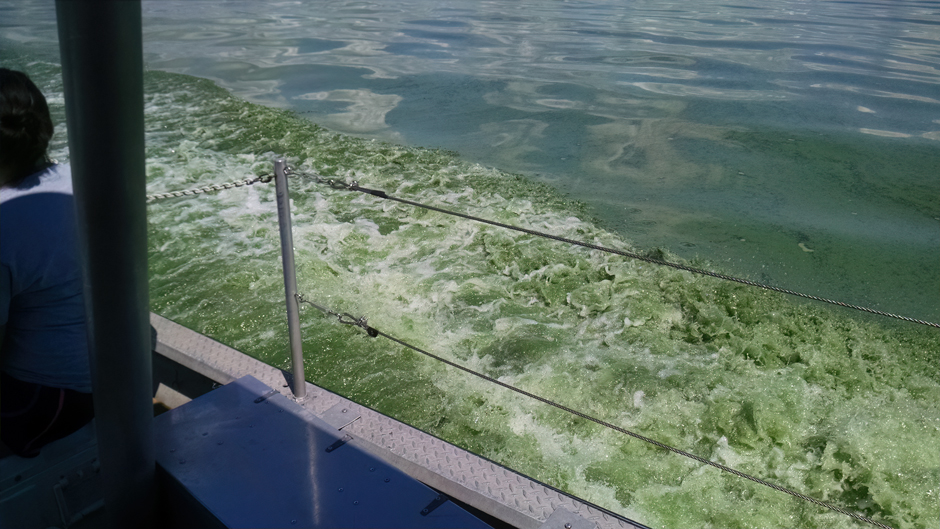 Picture of the 2015 bloom in Maumee Bay. (Credit: Justin Chaffin / The Ohio State University Stone Lab)
Picture of the 2015 bloom in Maumee Bay. (Credit: Justin Chaffin / The Ohio State University Stone Lab)Microcystin, one of several toxins produced by the cyanobacteria that form harmful algal blooms (HABs), has become a popular topic of lake research as the human health impacts of HABs become better understood. Stone Lab is one of the leading groups in algal bloom research on Lake Erie and other lakes in Ohio.
For more than 100 years, Stone Lab has conducted biology research and provided science education and outreach to the region. Over the years, thousands of individuals of varying ages have learned from the resources Stone Lab provides.
Stone Lab’s Research Coordinator and Senior Researcher, Justin Chaffin, learned of Stone Lab while an undergraduate student at Bowling Green State University Fireland Campus. During his research experience at Stone Lab, Chaffin learned a great deal about HABs and enjoyed the combination of fieldwork and lab analysis, choosing to remain there as a researcher after completing his studies.
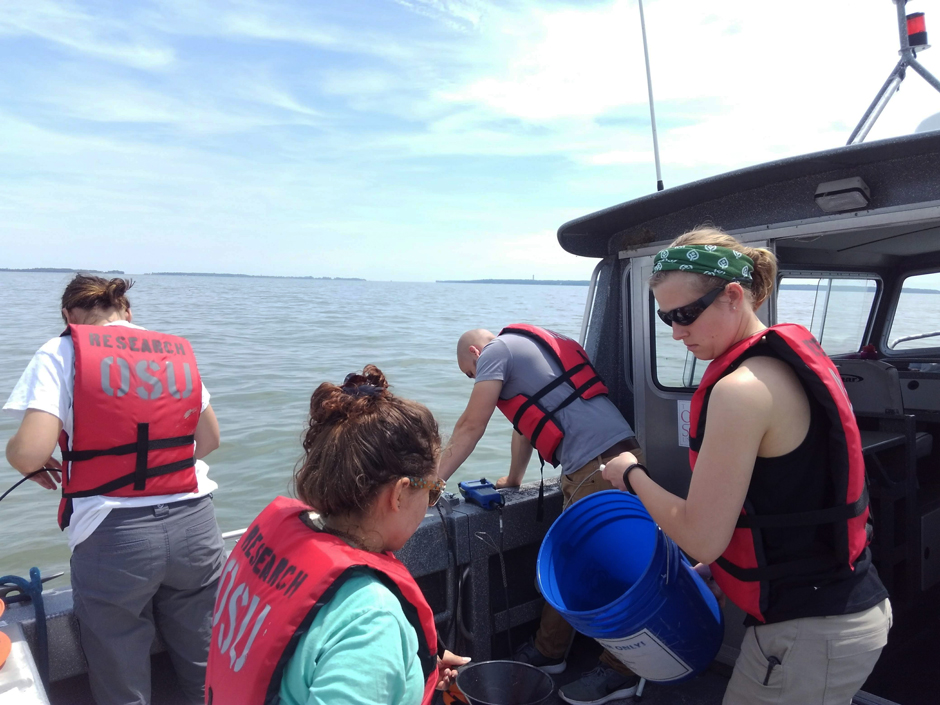
Chaffin’s crew collecting water samples aboard the R/V Erie Monitor. (Credit: Justin Chaffin / The Ohio State University Stone Lab)
Cyanobacteria in Lake Erie
Chaffin’s work at Stone Lab involves conducting his own cyanobacteria research in Lake Erie and other Ohio lakes as well as coordinating visits of outside researchers. Over the years, Chaffin has managed shorter-term studies and overseen the long-term real-time monitoring efforts occurring at the lake.
One of the more recent projects that Stone Lab has assisted in is the creation of a microcystin toxicity forecast for Lake Erie. The NOAA-led initiative sought to identify what controls how fast Microcystis produces microcystin. The data will then be used to construct a model that forecasts microcystin concentrations.
Chaffin explains, “The main thing we looked at is how cyanobacteria produce toxins. Why? When do they produce toxins? Where, and at what rate, are they producing toxins?” He continues, “Then we look at the why. What environmental factors are associated with that? Is it temperature? Is it light, phosphorus or nitrogen levels? Is it pH? What triggers cyanobacteria to produce toxins?”
The model will become a useful resource to water treatment operators, beach managers, and news media, who can report to the public toxicity and where to go on the beach to avoid blooms.
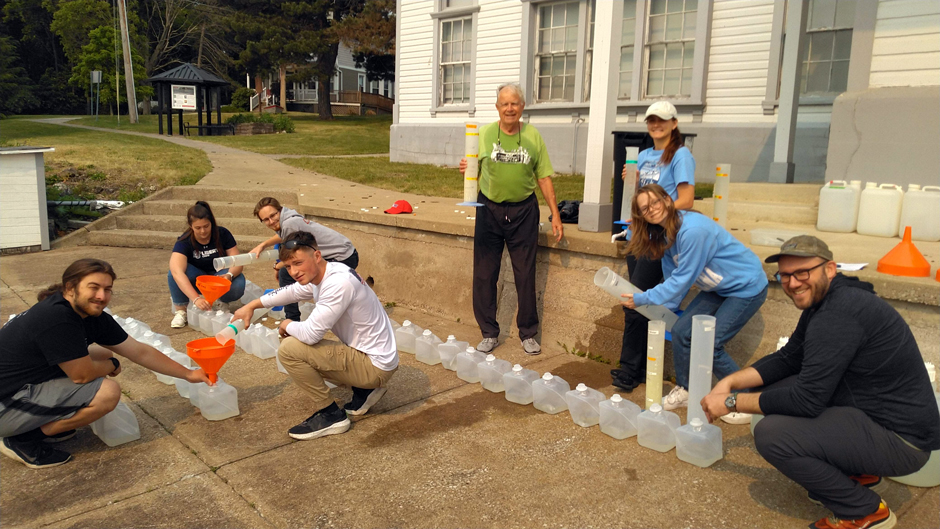
Researchers from the University of North Carolina and Bowling Green State University at Stone Lab setting up an experiment. (Credit: Justin Chaffin / The Ohio State University Stone Lab)
Real-Time Monitoring, Grab Sampling, and Mesocosms
Since 2014, Stone Lab has had a NexSens buoy deployed to gather real-time continuous data on Lake Erie. In 2016-2019, an additional buoy was deployed in a separate part of the basin in order to gather more data on conditions in other areas of Lake Erie.
In an ideal season, the real-time data allows researchers like Chaffin to view lake conditions before, during, and after cyanobacterial blooms. Being able to look over the collective data makes it easier to identify triggers of HABs.
Stone Labs’ monitoring program includes grab sampling to ensure the buoy’s data accuracy and to bridge the gap in data during the off-season, when the buoy isn’t deployed, due to lake conditions that could possibly damage the equipment.
In 2024, Stone Lab will deploy the newer buoy, a NexSens CB-1250 equipped with a YSI EXO2 and X2-CB data logger. The sonde collects data on various parameters known to influence and be indicators of cyanobacterial blooms, such as total algae and cyanobacteria levels, water turbidity, temperature, pH, fDOM, dissolved oxygen, and specific conductivity. Data from the sonde is logged every 15 minutes and then transferred to the cloud, where it is viewable from WQData LIVE.
Stone Lab also grows algae in laboratory-scale incubators, allowing for a controlled environment where the impact of various influences can be tested. Stone Lab also has a mesocosm facility with fifteen 600-gallon tanks that are used for a similar purpose but allow for much larger-scale testing.
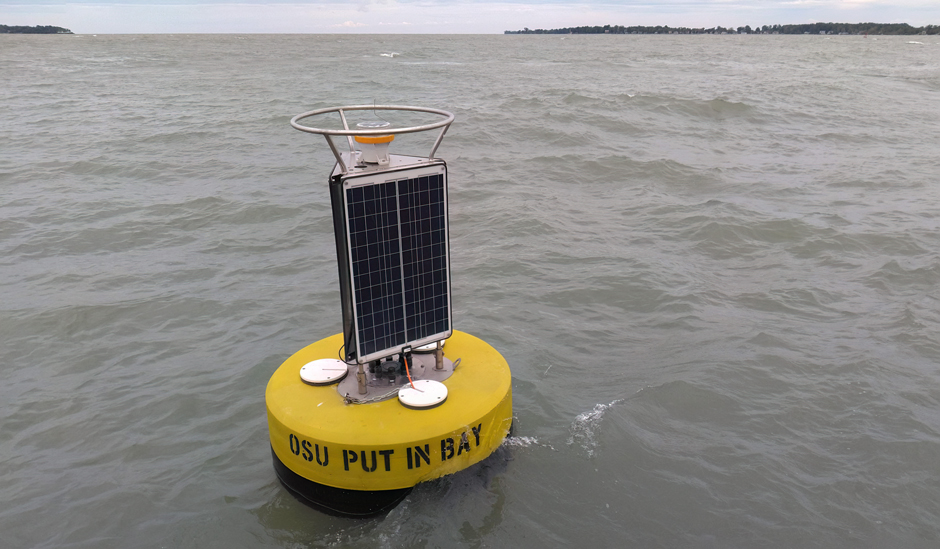
Pictures of our buoy in the water after being deployed from the R/V Gibraltar III. (Credit: Justin Chaffin / The Ohio State University Stone Lab)
Conclusion
The cyanobacterial blooms that have occurred in Lakes across the country in recent years can have long-term impacts and threaten water resources. Researching cyanobacteria behaviors is one step in ensuring that water bodies like Lake Erie are able to continue being used recreationally and for drinking water.
Chaffin explains, “We’re learning that these toxins can be volatilized and get in the air. So just standing on the beach can expose you to the toxins, but the main focus has been on producing safe drinking water. Ultimately, it comes down to people, and everyone needs access to clean water. Bottle water is expensive and wasteful. And most people like to play in the water. Whether it’s swimming or boating, fishing, or you’re strolling along the beach, everyone needs fresh water.”
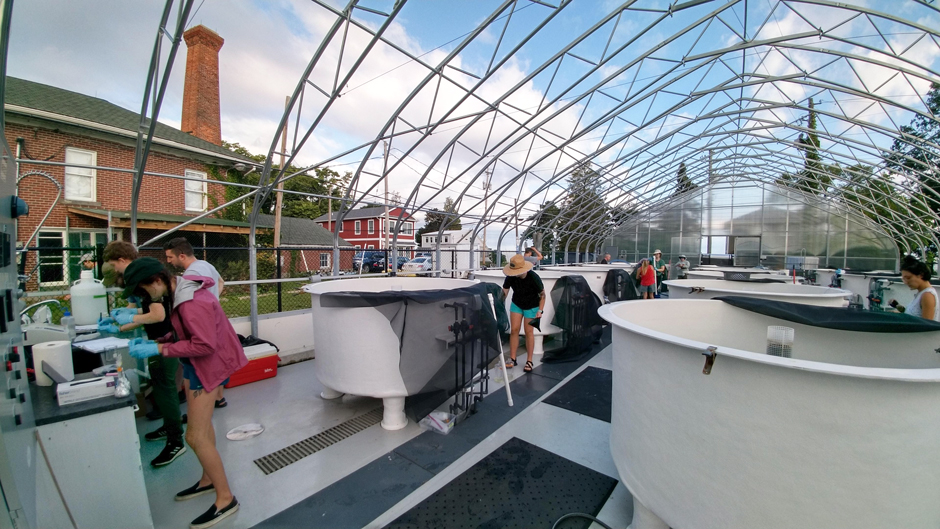
Researchers in Stone Lab’s mesocosm facility. (Credit: Justin Chaffin / The Ohio State University Stone Lab)




0 comments